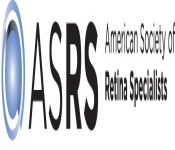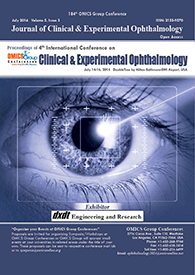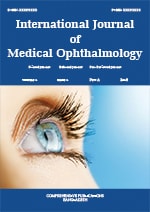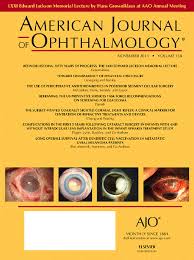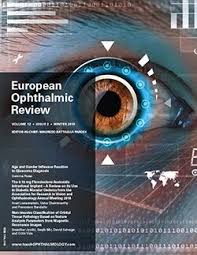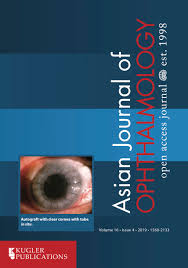Theme: Research and Technologies for Eye Care
Euro-Ophthalmology 2020
- About
- Session Track
- Market Analysis
- Learn More
- Participation options and Benefits
- YRF (Young Research Forum)
About:
The 34th European Ophthalmology Congress going to be held during November 23-24, 2020 on Webinars Meeting which brings together a unique and international mix of large and medium pharmaceutical, biotech and diagnostic companies, leading universities and clinical research institutions making the conference a perfect platform to share experience, foster collaborations across industry and academia, and evaluate emerging technologies across the globe. Ophthalmology Congress maximizes the opportunity to interact with and learn from your peers from across the country and across the globe it held with the discussions on Cornea and External Eye Disease, Retina and Retinal Disorders, Neuro-Ophthalmology, Glaucoma: Visual Field Loss, Ocular Microbiology and Immunology, Novel Approaches to Ophthalmology Therapeutics and many more.
Meet significant Ophthalmologists, Optometrists Researchers Clinicians from London. Rome, Japan ,Germany, Switzerland, Ireland, Russia, Singapore, Dubai, Saudi Arabia, China, Turkey, Spain, Taiwan ,Chicago, Korea, India , Australia and many more countries.
Conference Series llc LTD Organizes 300+ conferences, 500+ workshops and 200+ symposiums on Clinical, Medicine, Pharma and Science & Technology every year across USA, Europe, Asia, Middle East, Australia and UK with support from 1000 more scientific societies and Publishes 500 open access journals which contains over 30000 eminent personalities, reputed scientists as editorial board members.
Retinal disorders, optic atrophy, and lesions of the higher visual pathways are the main anatomical causes of visual loss in children. WHO reports that, 285 million people are estimated to be visually impaired worldwide: 39 million are blind and 246 have low vision. About 90% of the world’s visually impaired live in low-income settings 82% of people living with blindness are aged 50 and above. Globally, uncorrected refractive errors are the main cause of moderate and severe visual impairment; cataracts remain the leading cause of blindness in middle- and low-income countries. Many European associations are involved in Ophthalmology and many eye banks are actively promoting the donation of eyes in Europe, addressing a gap in the ophthalmic market, the global ophthalmic market was valued at $10.3 billion in 2010 and is estimated to reach $13.2 billion in 2017.
Objective:
Our aim is to provide cataract surgeons, refractive surgeons, optometrists , opticians, young researchers, students, industrial delegates and anyone professionally involved in study of cataract and refractive surgery with an opportunity to learn about the complexity of the disease, discuss interventional procedures, look at new and advanced cataract removal practices and their efficiency and efficacy in the treatment of various refractive errors and cataract extraction, and understand local realities and practical constraints in improving vision-care.
About Organizers
Conference has an enhanced and highlighted features of scientific partnerships and alliances with development agencies, Institutes, leading research organizations, non-government organizations, and other entities to promote the development-oriented research across the globe through live streaming, B2B and Scientific Meetings. Medical Conferences provides an excellent opportunity for the budding scientists and young researchers through its special initiatives like Young Researcher Forum, Poster Presentation and E-poster .
Target Audience
Ophthalmologists, Optometrists, Opticians, Doctors, Researchers, Students, Industrial Delegates from Academia and Research along with the industrial professionals from biomedical companies and healthcare sectors.
·Clinical researchers & Scientists
.Medical Practitioners, Professors, Deans, Students & Technicians
.Medical & Health care Organizations & Associations
.Idiopathic Intracranial Hypertension – Ocular Migra
Diagnostic Instruments in Optometry
Session/Tracks
Track 1:
The Retina is a slight layer of tissue within back mass of your eye. It contains a large number of light-delicate cells and other nerve cells that get and compose visual data. Your retina sends this data to your cerebrum through your optic nerve, empowering you to see. Retinal degenerative issue, for example, Age-related macular degeneration and near sighted macular degeneration influencing youthful and old from numerous societies, races and ethnicities. Clinical Ophthalmology indicates the duties of practitioner in an eye clinic and it also covers the broad spectrum of research from beside to bench side and plays a crucial in screening, diagnosis and therapeutics to treat eye illness. The focal zone of the retina contains a high thickness of shading delicate photoreceptor cells called cones which are in charge of shading vision and thus any deformity and modification in the focal territory of the retina will prompt Colour vision imperfections. Then again ailments like Diabetic retinopathy and Retinal tumors and other specific Eye Disease can likewise be in charge of the lasting vision misfortune in the event that it is not treated on time. Generally, retinal malady has had a low need in avoidance of visual deficiency programs in creating nations. Age-related macular degeneration (AMD) is a retinal degenerative sickness that causes a propelled loss of focal vision. Some retinal sicknesses are innate, static hemeralopia and diffuse yellow or dim hue of the fundus. Following 2 or 3 hours in all out murkiness, the typical shade of the fundus returns.
- Diabetic retinopathy
- Retinal Tumors
- Retinal Detachment
- Retinopathy of Prematurity Ophthalmologic Approach
- Retina and Retinal Surgery
Related Societies:
USA: American Society of Retina Specialists, Retinal American Academy of Ophthalmology , Optometric Retina Society, Pan America Glaucoma Society, American Glaucoma Society
Europe: European Society of retina Specialists, European Vitroretinal Society, European Glaucoma Society, European Society of cataract and refractive surgeons, European Mucosal Immunology Group
Asia Pacific: Japanese society of Cataract and refractive Surgeons, Asia Pacific Vitro retinal Societies , Asia Cornea Society, Afro-Asian Council of Ophthalmology , Asian Angle-Closure Glaucoma Club
Track 2: Cornea Disorders and Treatments
Eye is composed of very sensitive and fragile tissues and every part of an eye serves its own function to maintain its normal vision. The cornea is the transparent front part of the eye that covers the iris, pupil, and anterior chamber. The Cornea, with the anterior chamber and lens, refracts light, with the cornea accounting for approximately two-thirds of the eye's total optical power. But factors such as corneal ulceration, epithelial keratitis & drug-induced epithelial keratitis, corneal regeneration, recurrent corneal erosion and miscellaneous corneal disorders can affect the cornea and ultimately lead to the external eye disease that could end up with permanent blindness. Hence investigation of corneal disease is carry out to mitigate the disease and methods like Contact lenses & vision correction is also use to cure the vision related problems and surgical procedure like corneal transplantation is used to transplant the cornea. The cornea and focal point of the eye are worked to concentrate light on the retina, which is the light-touchy tissue at the back of the eye. At the point when light strikes the cornea, it twists or refracts the light approaching onto the focal point. The focal point refocuses that light onto the retina, which begins the interpretation of light into vision. The retina changes over light into electrical driving forces that go through the optic nerve to the mind, which translates them as pictures.
- Focus on Dry Eye and Blepharitis
- Corneal neovascularizatio
- Epithelial keratitis & drug-induced epithelial keratitis
- Recurrent corneal erosion
- Corneal degeneration
Related Societies:
USA: North American Neuro Ophthalmology Society, Latin American Association of Optometry and Optics , Pan American Association of Ophthalmology
Europe: European Association for the Study of Diabetic Eye Complications, European Association for Vision and Eye Research, European Retina, Macula and Vitreous Society , South-East European Ophthalmological Society
Asia Pacific: Asia Pacific Council of Optometry , Asia-Pacific Glaucoma Society, Asia Pacific Academy of Ophthalmology, Asia-Pacific Academy of Ophthalmology, Australian Society of Ophthalmologists
Track 3: Glaucoma
Glaucoma is a multifactorial optic neuropathy that influences more than 50 million individuals and is the second driving reason for visual deficiency around the world. The part of intra Ocular Pressure (IOP) has been all around recorded as a noteworthy modifiable danger variable for glaucoma. Also, numerous glaucoma patients have a generally low IOP, while some solid people have a moderately high IOP. Pathophysiology of glaucoma demonstrates towards the expanded in intraocular weight which packs and harms the optic nerve. Once the optic nerve is harmed, it neglects to convey visual data to the mind and this outcome in loss of vision. Biomarkers for glaucoma and Vision Problem have prescient utilize that could help and direct more particular treatment in some glaucoma patients. Endothelia in glaucoma treatment assume an exceptionally enter part in pathogenesis of glaucoma. Regarding Social Security advantages, lost wage charge incomes, and medicinal services consumptions, the expense to the U.S. government is assessed to be over $1.5 billion every year. The Glaucoma Research Society of Canada is the main Canadian non-benefit association exclusively committed to financing glaucoma research. Following 1989, it has raised more than two million dollars in backing of 150 examination ventures. The Society reserves 10 to 15% of all autonomous glaucoma research in Canada. Bascom Palmer and Wills Eye are the top scientist association for glaucoma.
- Open angle and closed angle glaucoma
- Biomarkers for Glaucoma
- Gonioscopy procedure
- Impaired ocular blood flow regulation in open angle glaucoma
- How to use Resources to Prevent Glaucoma Related Visual Impairment and Blindness
- IOP Lowering Molecules: New Ways and Old Problems (Intraocular Pressure)
- Ophthalmology Surgery
Related Societies:
USA: North American Neuro Ophthalmology Society, Latin American Association of Optometry and Optics , Pan American Association of Ophthalmology
Europe: European Society of Ophthalmology, European Eye Bank Association , Association of European Ocularists , European Strabismological Association
Asia Pacific: Afro-Asian Council of Ophthalmology , Asian Angle-Closure Glaucoma Club , Academy of Asia-Pacific Professors of Ophthalmology , Asian Oceanic Glaucoma Society
Track 4: Ophthalmology Surgery
There is an assortment of conditions that might call for eye surgery; from corrective changes to vision-sparing strategies by surgeons. Surgery is the clinical ophthalmic research involving eye disorders, vision, medical, surgical and optical care. Every treatment accompanies its own advantages, dangers, and signs for use. From restorative medications to orbital inserts, today's headways can handle any condition and give an effective arrangement.
- Orbital decompression surgery
- Tear duct surgery
- Refractive surgery
- Vision Correction Surgery
- Retinal Replacement Surgery
- Cataract Surgery
- Plastic Surgery
- Glaucoma Surgery
Related Societies:
USA: American Association of Eye and Ear Hospitals, American Optometric Association , Canadian Association of Optometrists , Ohio Optometric Association
Europe: European Society of Veterinary Ophthalmology, European Council of Optometry and Optics, European Paediatric Ophthalmology Society, European Society of Cataract and Refractive Surgeons
Asia Pacific: Asian Neuro-ophthalmology Society, Asian Angle Closure Glaucoma Club, Asia Pediatric Ophthalmologists Association , Asia Pacific Society of Ophthalmic Plastic and Reconstructive Surgery
Track 5: Ocular Microbiology and Ocular biochemistry
A large number of the infections, microscopic organisms, parasites, and growths that can attack the human body are additionally equipped for assaulting the surface or inside of the eye. The regular inclination for immunologic malady to influence the eye gets from various components, for example, Antibody-subordinate and immunizer intervened infections, Uveitis, intraocular aggravation and cell-interceded sicknesses. The field of ocular microbiology includes studies on ocular infections, ocular pathogens, current antibiotic susceptibility data etc. The safe framework assumes a basic part amid transplantation and as the corneal transplantation has turned out to be progressively normal since the 1960s and more than 40,000 transplants were performed in 1990 in the United States and Canada. The 5-year disappointment rate for corneal unions is roughly 35%; corneal union dismissal is the most well-known reason for joining disappointment in the late postoperative period yet with the late improvement in immunotherapy can be a leap forward to overcome from every one of the restrictions of the customary techniques. The microbiological contamination, for example, contagious endophthalmitis can influence the vitreous and front assembly of the eye and subsequently the employments of anti-toxin in visual diseases have been expanded to beat these conditions. The consumables, hardware and innovation markets in the microbiology business, almost $7.7 billion in 2012. This aggregate is relied upon to develop from $8.5 billion in 2013 to $11.4 billion in 2018, with a compound yearly development rate (CAGR) of 6.1% for the five-year period, 2013 to 2018.
- Biochemistry of Vision
- Ocular Fluids
- Genetic basis of Retinoblastoma
- Photochemistry of Vision
- Photochemistry of Vision
- Metabolism of Cornea
- Blepharitis
- Bacterial Conjunctivitis
- Viral Conjunctivitis
- Dendritic Keratitis
- Folliculitis
Related Societies:
USA: American College of Veterinary Ophthalmologists, New England Ophthalmological Society, American Academy of Optometry, American Ophthalmological Society, American Society of Ophthalmic Administrators
Europe: European Society of Ophthalmology, South-East European Ophthalmological Society , European Contact Lens Society of Ophthalmologists , European Glaucoma Society
Asia Pacific: Asia Pacific Association of Cataract Refractive Surgeons , Australian Society of Ophthalmologists, All India Ophthalmological Society
Track 6: Ocular Diseases
As ocular oncology is a highly specialized field of ophthalmology, there is active international collaboration between ocular oncologists. Ocular oncology is a multidisciplinary service which includes general oncologists, pediatric oncologists, specialist nurses, clinical scientists and many others. The most common malignancies include uveal and conjunctivitis melanoma, uveal metastasis, intraocular and conjunctiva lymphoma and conjunctiva carcinoma. As well as the management of confirmed malignant tumors, ocular oncologists receive a large number of referrals of patients with suspected malignant tumors. Diagnosis is based on bio microscopy, ultrasonography, angiography, optical coherence tomography, auto fluorescence imaging and biopsy. The most common benign tumors include naevi, chorodal haemangioma. Vasoproliferative tumors and retinal haemangioblastomas. Many of these lesions require treatment and/or long-term surveillance. Eyelid and orbital tumors are more likely to be managed within oculoplastic or orbital specialist services.
- Biochemistry of Vision
- Ocular Fluids
- Ocular Oncology
- Anisocoria
- Astigmatism
- Lagophthalmos
- Black eye
- Amblyopia
- Onchocerciasis
- Loiasis
- Macular Oedema
- Blepharochalasis
- Heterochromia iridis
- Hyphema
- Iridodialysis
Related Societies:
USA: Canadian Ophthalmological Society , Optical Society of America, Latin American Association of Optometry and Optics , American Association of Ophthalmic Oncologists and Pathologists, American Society of Ocular Trauma
Europe: European Society of Cornea & Ocular Surface Disease Specialists , European Union of Medical Section of Ophthalmology, European University Professors in Ophthalmology
Asia Pacific: Hong Kong Ophthalmological Society, Indonesian Ophthalmologists Association , Malaysian Society of Ophthalmology, Singapore Society of Ophthalmology
Track 7: Ophthalmic Disorders:
This is an accumulation of contextual analyses to offer you some assistance with getting an understanding on the common history and starting examination of different ophthalmic issue. Ophthalmic Research mainly focuses on medical and surgical techniques and treatments involved in the management of eye diseases. The discourse, albeit brief, is expected to give you a basic diagram of every illness. Myopia is a condition of eye where the light that comes in doesn't directly concentrate on the retina however ahead of it, inflicting the image that one sees once viewing a far off object to be out of focus, however focused once viewing at a closer object.
- Anatomy.
- Refractive Errors.
- Age-Related Macular Degeneration.
- Cataract.
- Diabetic Retinopathy.
- Amblyopia.
- Strabismus
- Night Blindness
- Red Eyes
- Eyestrain
- Lazy Eye
- Uveitis
- Colorblindness
- Floaters
- Dry Eyes
- Conjunctivitis (Pinkeye)
Related Societies:
USA: American Society of Ophthalmic Plastic and Reconstructive Surgery, Brazilian Society of Ophthalmology, Eye Bank Association of America, North American Neuro-Ophthalmology Society , Pan American Society of Ocular Oncology
Europe: Belgian Society of Cataract and Refractive Surgery, French Society of Ophthalmology, German Ophthalmological Society
Asia Pacific: Japanese Retinitis Pigmentosa Society, Middle East Africa Council of Ophthalmology
Track 8: Pediatric Ophthalmology
Pediatric ophthalmologists focus on the development of the visual system and the various diseases that disrupt visual development in children. Pediatric ophthalmologists also have expertise in managing the various ocular diseases that affect children. Pediatric ophthalmologists are qualified to perform complex eye surgery as well as to manage children's eye problems using glasses and medications. Many ophthalmologists and other physicians refer pediatric patients to a pediatric ophthalmologist for examination and management of ocular problems due to children's unique needs. In addition to children with obvious vision problems, children with head turns, head tilts, squinting of the eyes, or preferred head postures (torticollis) are typically referred to a Pediatric ophthalmologist for evaluation. Pediatric ophthalmologists typically also manage adults with eye movement disorders (such as nystagmus or strabismus) due to their familiarity with strabismus conditions.
- Pediatric Cataract
- Pediatric Glaucoma
- Pediatric Optometry ResearchSquint
- Retinopathy of Prematurity
- Pediatric Vision Care
- Childhood Malignancies
- Congenital Cataract
- Congenital Glaucoma
Related Societies:
USA: Pan American Society of Ophthalmic Pathologists, Argentinian Society of Ophthalmology , Laos Society of Ophthalmology , Mexican Society of Ophthalmology, Retina International
Europe: Israel Society for Vision and Eye Research, Italian Society of Ophthalmology, Netherlands Ophthalmological Society, Turkish Ophthalmological Society
Asia Pacific: ASEAN Ophthalmological Society, Ophthalmological Society of Taiwan, Optometrists Association Australia, The Hong Kong Association of Private Practice Optometrists
Track 9: Neuro Ophthalmology
Neuro-ophthalmology is the consolidation of neurology and ophthalmology, frequently managing complex systemic sicknesses that have signs in the visual framework. Cerebral Visual Impairment (CVI) incorporates every single visual brokenness created by harm to, or breaking down of, the retrochiasmatic visual pathways without harm to the foremost visual pathways or any significant visual ailment. Vision problems can be described as the decreased ability to view things. There are many varieties of eye problems and vision disturbances, myopia, halos, blurred vision etc. The impaired vision or vision problems will reduce the sharpness of images. It usually hampers the daily activities of a person. Myasthenia gravis is brought about by a breakdown in the typical correspondence in the middle of nerves and muscles which prompts two fold vision, hanging eyelids and different muscles shortcoming which affecting the both i.e. neuromuscular action furthermore vision. Demonstrative instruments in Neuro-ophthalmology are utilized to explore and to treat the different state of Neuro-ophthalmology as Neonatal visual examination are basically performed to screen the vicinity and movement of Retinopathy of Prematurity. College of Pennsylvania is presently taking a shot at Neuro-ophthalmology venture. Treatment of Neuro Ophthalmology will rely upon one's analysis and furthermore contain medicinal treatments, botulinum poison infusions to stop muscle fit for disarranges, for example, hemifacial fit, laser surgery for various vision issue and surgical medications, as for eye muscle surgery to reestablish straight eye arrangement.
- Papilledema
- Optic Neuritis
- Optic Nerve Disorders
-
Optic Neuropathy
Related Societies:
USA: World Glaucoma Association, The Foundation Fighting Blindness Canada, Ophthalmological Society of South America, Latin American Glaucoma Society
Europe: International Strabismological Association , World Glaucoma Association, International Ocular Inflammation Society, International Society for Low Vision Research and Rehabilitation
Asia Pacific: The Hong Kong Optometric Association, Indian Optometric Association, Indonesian Optometrists Association, Japan Optometric Association
Track 10: Advanced Ophthalmological Care
Advanced Vision Care in is dedicated to providing state-of-the-art, individually based, high quality, and eye health care. Cover a range of eye problems including cataracts, glaucoma, corneal disease, dry eye, retinal disorders, and ocular injuries. We have the common goal of ascertaining the most appropriate care for any given patient, explaining the purpose of the treatment, and in initiating said therapy in a courteous and compassionate manner irrespective of age, gender, nationality, race, or payment program. Various processes in Primary and secondary Eye Care include critical awareness, eye examinations, rehabilitation and long-term continuity of care which are carried out through health centres. Eye care is an integral part of ophthalmic sciences. There are several eye care societies and organisations who work to bring these services at door step
- Femtosecond laser-assisted cataract surgery
- Transplantation technologies for retina
- Corneal reshaping & transplantation
- Drugs used in the treatment of allergic conjunctivitis
- Diagnostic dye solutions
- ECP patient Marketing
- Value Chain Concept
- Innovations in Optometric Appliances
- Light-adjustable IOLs
- Choroidal imaging
Related Societies:
USA: Association for Research in Vision and Ophthalmology , International Society of Ocular Oncology , International Society of Contact Lens Specialists, International Council of Ophthalmology
Europe: Spanish Society of Ophthalmology, European Society for Low Vision Research and Rehabilitation , European Union of Ophthalmology Specialists
Asia Pacific: Korean Optometric Association, All Japan Optometric and Optical Association, Association of Malaysian Optometrists, New Zealand Association of Optometrists
Track 11: Optometry and Vision Science
Optometry is a healthcare profession which involves examining the eyes and applicable visual systems for defects or abnormalities as well as the medical diagnosis and management of eye disease. Traditionally, the field of optometry began with the primary focus of correcting refractive error through the use of spectacles. Vision science is an interdisciplinary study of visual systems and perception and incorporates many disciplines, including optometry, ophthalmology, molecular genetics, neuroscience and physiological optics.
- Optic and Radiations
- Optical Power of the Eye
- Stereopsis: 3D Vision
- Biophysics of vision
- Contact Lens
- Spectacle Lens
- Optic Nerve Disease
- Optical Power of the Eye
- Optic and Radiations
Related Societies:
USA: World Council of Optometry, International Society for Eye Research, American Society of Ocular Trauma, International Society for Genetic Eye Diseases and Retinoblastoma
Europe: International Strabismological Association , World Glaucoma Association, International Ocular Inflammation Society, International Society for Low Vision Research and Rehabilitation
Asia Pacific: Optometric Association of the Philippines, Nepalese Association of Optometrists, Singapore Optometric Association, Sri Lanka Optometric Association
Track 12: Orbital Disorders
Orbital inflammation (inflammatory orbital pseudotumor) can affect any or all structures within the orbit. The inflammatory response can be nonspecific, granulomatous, or vasculitic or due to reactive lymphoid hyperplasia. The inflammation can be part of an underlying medical disorder or can exist in isolation. Patients of all ages can be affected. The process can be acute or chronic and can recur. The orbit (the eye socket) and the eyelids work in conjunction to protect the eye and its muscles. Ophthalmoscopy is done as a part of an eye exam and will be done as part of a routine physical exam. Various tumours may grow or spread to the eye socket or the eyelids and must be removed in order to protect our patient’s vision.
- Graves Ophthalmology
- Orbital Cellulitis
- Rhabdomyosarcoma
- Lacrimal Sac Disorder
Related Societies:
USA: Brazilian Laser Ophthalmology Surgical Society, American association for Pediatric Ophthalmology and strabismus, America Ophthalmological Society, International Society for refractive surgery
Europe: European Union of Ophthalmology Specialists, Spanish Society of Ophthalmology, European Society for Low Vision Research and Rehabilitation
Asia Pacific: All India Orthoptic Society, Australian and New Zealand Strabismus Society, Austrian Academy of Ophthalmology and Optometry, Egyptian Group of Pediatric Eye Surgery
Track 13: Ophthalmic Drug Delivery
New ophthalmic drug delivery systems are currently receiving increased attention, in part because of the expected emergence of new drugs with short biological half-lives whose usefulness may depend on a more continuous drug supply than eye drops can provide, but also because of the potential of some delivery systems to reduce the side effects of the more potent drugs. Various strategies for ocular drug delivery are considered; from basic formulation techniques for improving availability of drugs. The use of drug-loaded contact lenses and ocular inserts allows drugs to be better placed where they are needed for more direct delivery. Ophthalmic imaging involves the process of using a camera to photograph the eye and its related structures especially retina. One of the common ophthalmic imaging technique is optical coherence tomography. A development in ocular implants gives a means to overcome the physical barriers that traditionally prevented effective treatment. Implant technologies are under development allowing long-term drug delivery from a single procedure; these devices allow posterior chamber diseases to be effectively treated. Future developments could bring artificial corneas to eliminate the need for donor tissue and one-off implantable drug depots lasting the patient's lifetime.
- Ocular and systemic side effects of drugs
- IVT injection-sparing approaches
- Transplantation technologies for retina
- Oral and topical nonsteroidal anti-inflammatory agents (NSAIDs)
Related Societies:
USA: International Strabismological Association, Joint Commission on Allied Health Personnel in Ophthalmology, Puerta Rican Society of Ophthalmology, Canadian Ophthalmic Pathology Society
Europe: Czech Ophthalmological Society, Danish Ophthalmological society, Finnish Ophthalmological Society, International Ocular Inflammation Society
Asia Pacific: Indonesian Pediatric Ophthalmology and Strabismus Society, Myanmar Ophthalmological Society, Pediatric Ophthalmology Subdivision, Pediatric Keratoplasty Association
Track 14:Ophthalmology Practice
An understanding of the commonly used ophthalmic instruments is essential for any practising ophthalmologists. Ophthalmic instruments according to procedures should be carefully handled by skilled and knowledgeable Ophthalmologists. Improving practice efficiency is more likely to be successful when undertaken with a long-term view as well as an understanding of trends in the healthcare environment. Clinical ophthalmology or Ophthalmology Practice perform diagnose and operates on eyes, by clinical techniques a multitude of diseases and conditions can be diagnosed from the eye. Most ophthalmologists practice a mixture of medicine and surgery, ranging from lens prescription and standard medical treatment to the most delicate and precise surgical manipulations.
- Have a comprehensive dilated eye exam
- Eat right to protect your sight
- Maintain a healthy weight
- Wear protective eyewear
- Quit smoking or never start
- Be cool and wear your shades
- Give your eyes a rest
- Clean your hands and your contact lenses properly
- Practice workplace eye safety
Related Societies:
USA: American Society of Retina Specialists, Retinal American Academy of Ophthalmology , Optometric Retina Society, Pan America Glaucoma Society, American Glaucoma Society
Europe: European Society of retina Specialists, European Vitroretinal Society, European Glaucoma Society, European Society of cataract and refractive surgeons, European Mucosal Immunology Group
Asia Pacific: Japanese society of Cataract and refractive Surgeons, Asia Pacific Vitro retinal Societies , Asia Cornea Society, Afro-Asian Council of Ophthalmology , Asian Angle-Closure Glaucoma Club
Track 15: Cataract: Vision Problem
Cloudy area that structures in the eye's basic focal point is known as Cataract. It makes at bit by bit and at last starts intruding with the vision. People may end up with Cataracts in the two eyes, yet they generally don't shape meanwhile. Waterfall is an incredibly typical subject to be discussed in the Ophthalmology Conferences. Waterfall is one of the consistent afflictions in more prepared people.50% of the masses in the United States and Europe have waterfalls and have transformed into the most generally perceived reason of vision incident on the planet. As a rule, the finding of a waterfall is genuinely basic. Be that as it may, in the pre-birth populace, in spite of the fact that analysis is conceivable it is more troublesome. Ultrasounds have demonstrated a compelling strategy to distinguish waterfalls in unborn youngsters. It is basic that they be identified early if present as waterfalls in infants can bring about visual impairment forever if not treated legitimately and rapidly not long after birth. Late examinations demonstrate that the frequency of waterfalls is significantly higher contrasted with that of diabetic retinopathy and Glaucoma. It has turned into the most widely recognized malady in maturing grown-ups and ends up being an unavoidable backup amid seniority.
- Nuclear cataract
- Cortical cataract
- Posterior subcapsular cataract
- Congenital cataracts
Related Societies:
USA: Canadian Ophthalmological Society , Optical Society of America, Latin American Association of Optometry and Optics , American Association of Ophthalmic Oncologists and Pathologists, American Society of Ocular Trauma
Europe: European Society of Cornea & Ocular Surface Disease Specialists , European Union of Medical Section of Ophthalmology, European University Professors in Ophthalmology
Asia Pacific: Hong Kong Ophthalmological Society, Indonesian Ophthalmologists Association , Malaysian Society of Ophthalmology, Singapore Society of Ophthalmology
Track 16: Latest and Innovative Eye Research
Eye surgery, generally called visual surgery, can't avoid being surgery performed on the eye or its adnexa, typically by an ophthalmologist. The eye is a sensitive organ, and requires astounding thought some time as of late, in the midst of, and after a surgical procedure. An authority eye master is responsible for choosing the fitting surgical framework for the patient, and for taking the imperative security wellbeing measures. Ophthalmic surgeries can be of different sorts who incorporate Laser eye surgery, waterfall surgery, glaucoma surgery, refractive surgery, corneal surgery, vitreo-retinal surgery et cetera.
Since the eye is strongly connected with nerves, anesthesia is vital. Neighborhood anesthesia is most frequently used. Topical anesthesia using lidocaine topical gel are routinely used for rapid techniques. Since topical anesthesia requires interest from the patient, general anesthesia is every now and again used for youths, horrendous eye wounds, and major orbitotomies for dubious patients. The specialist controlling anesthesia screens the patient's cardiovascular status. Clean security measures are taken to set up the domain for surgery and lower the peril of sullying. These security measures join the use of cleaning operators, for instance, povidone-iodine, and sterile window hangings, outfits and gloves.
- Video Keratoscopy
- Spectral-domain Optical Coherence Tomography
- OCT Angiography
- Small Gauge Endoscopy
- Optical Coherence Tomography (OCT) Imaging Systems
- Femtosecond laser-assisted cataract surgery
- Transplantation technologies for retina
- Corneal reshaping & transplantation
- Drugs used in the treatment of allergic conjunctivitis
- Diagnostic dye solutions
- ECP patient Marketing
- Value Chain Concept
- Innovations in Optometric Appliances
- Light-adjustable IOLs
- Choroidal imaging
Related Societies:
USA: International Strabismological Association, Joint Commission on Allied Health Personnel in Ophthalmology, Canadian Ophthalmic Pathology Society
Europe: Danish Ophthalmological society, Finnish Ophthalmological Society, International Ocular Inflammation Society
Asia Pacific: Myanmar Ophthalmological Society, Pediatric Ophthalmology Subdivision, Pediatric Keratoplasty Association
Track 17: Veterinary Vision
Veterinary vision is an ophthalmic practice providing care for companion animals. The veterinarians are treating dogs, cats and other small animals including rabbits, chinchillas, birds and reptiles, Horses and other farm animals. Some veterinary eye diseases are given below.
- Entropion. Entropion
- Corneal Ulcer
- Corneal Dystrophy
- Glaucoma
- Retinal Detachment
Related Societies:
USA: International Strabismological Association, Joint Commission on Allied Health Personnel in Ophthalmology, Canadian Ophthalmic Pathology Society
Europe: Danish Ophthalmological society, Finnish Ophthalmological Society, International Ocular Inflammation Society
Asia Pacific: Myanmar Ophthalmological Society, Pediatric Ophthalmology Subdivision, Pediatric Keratoplasty Association
Track 18: Genetic Therapy in Ophthalmology
Gene therapy is an exploratory technique that employs genes to treat or prevent diseases. In near future, this technique may include a doctor replacing the mutated gene with a healthy copy of the gene to the patient in order to cure the abnormalities instead of surgery or drugs. Ophthalmic genetics is a branch of ophthalmology which refers to the field where the genetic background of disease is researched. Leber Congenital Amaraius(LCA) is a hereditary genetic disease that causes childhood blindness. Scientists and doctors have treated this disease with the help of gene therapy
- Genetics of Myopia Development
- Gene Therapy
- Usher syndrome
- Familial exudative vitreal retinopathy
- Retinoblastoma
- Leber hereditary optic neuropathy (LHON)
- Optic atrophy
- Genetics of Myopia Development
Related Societies:
USA: International Strabismological Association, Joint Commission on Allied Health Personnel in Ophthalmology, Canadian Ophthalmic Pathology Society
Europe: Danish Ophthalmological society, Finnish Ophthalmological Society, International Ocular Inflammation Society
Asia Pacific: Myanmar Ophthalmological Society, Pediatric Ophthalmology Subdivision, Pediatric Keratoplasty Association
Track 19: Ophthalmic Lenses and Laser Treatment
Ophthalmic Lens is a lens which corrects the vision in a person where the focal point in the eyes does not hit the retina. They come in a variety of forms including plastic and glass lenses worn in glasses, contact lenses placed in direct contact with the eye, and lens implants surgically inserted into the eye to correct visual impairments. Basic ophthalmic lenses correct for near- or farsightedness, where the focus point lies in front of or behind the retina. They curve to adjust the focal point and let light hit the retina precisely, allowing people to focus. Other lenses can have additional features along with Lasers are essential surgical tools for the 21st-century ophthalmologist. With these devices, surgeons can treat a vision-robbing disease such as glaucoma, macular degeneration and diabetic retinopathy.
- Single-Vision lens
- Bifocal Lens
- Trifocal Lens
- Progressive Lens
- Rigid gas permeable lenses
- Intraocular Lenses Aspheric IOLs
- Accommodating IOLs
- Photocoagulation
- Photovaporization
- Photodynamic.
Related Societies:
USA: International Strabismological Association, Joint Commission on Allied Health Personnel in Ophthalmology, Canadian Ophthalmic Pathology Society
Europe: Danish Ophthalmological society, Finnish Ophthalmological Society, International Ocular Inflammation Society
Asia Pacific: Myanmar Ophthalmological Society, Pediatric Ophthalmology Subdivision, Pediatric Keratoplasty Association
Track 20: Ayurvedic Treatment and Exercise in Ophthalmology
The eyes are more exact witnesses than the ears". While this may not be totally valid, there's no preventing the significance from claiming your vision. Sadly, similar to the case is with every single other organ in your body, your eyes are likewise inclined to different conditions that can cause crumbling of visual perception or finish vision misfortune. To those of us favoured with great or even poor vision, the possibility of finish vision misfortune can appear to be scary or astonishing. This is the reason eye activities and herbs to enhance visual perception have turned out to be so prevalent lately. To get best Result from Ayurvedic Therapy in Ophthalmology there are some Exercise that we can follow, because our eyes have muscles and they can get sore when held in one position for too long, just like any other muscle of the body. Give your eye muscles a break and you will be very grateful over the years. By doing even a few of these exercises you may well increase our productivity, eliminate headaches and errors, and even reduce your risk of glaucoma. And you don’t even have to take time off for these exercises so a busy schedule should be no excuse.
- Triphala
- Ginkgo Biloba
- Fennel Seeds & Almonds
- Rose Water
- Palming
- Blinking
- Zooming
- Shifting
- Figure of eight
Related Societies:
USA: International Strabismological Association, Joint Commission on Allied Health Personnel in Ophthalmology, Canadian Ophthalmic Pathology Society
Europe: Danish Ophthalmological society, Finnish Ophthalmological Society, International Ocular Inflammation Society
Asia Pacific: Myanmar Ophthalmological Society, Pediatric Ophthalmology Subdivision, Pediatric Keratoplasty Association
Market Analysis Report of 2nd conference:
34rd European Ophthalmology Congress, Webinars, Nov 23-24 | 2020
Euro-Ophthalmology 2020: According to a study it is estimated that around 48% of world population is blind because of cataract and more than 60 million people suffer from glaucoma and it is estimated that the number would rise to 80 million by the end of 2020. Ageing population is the leading cause for refractive error problem in countries like the USA and Europe, it is noticed that the refractive error problem is mostly seen in population ageing more than 40 years.
After a huge downfall of the market during economic drain in 2008-2009, ophthalmology market is catching up to get back to the normal as there is a rapid growth in population resulting in increased number of patients with eye diseases and the incidence of cataract and glaucoma are increasing every year.
Importance and scope:
The field of Ophthalmology: Ocular treatment & care is growing rapidly and its development is making tremendous impacts in medical and health sciences and pharmaceuticals. The importance and significance can be gauged by the fact that it has made huge advancements over the course of time and is continuing to influence various sectors. Euro-Ophthalmology 2020 conference will concentrate on latest and exciting innovations in areas of eye surgeries, diagnostics and recent technologies towards eye care. It will also provide an excellent opportunity to meet the leading eye surgeons, top class eye care specialists, ophthalmologists, optometrists, research scientists and the young student research community working the related field.
Euro-Ophthalmology 2020 Conference is designed to comprise of Keynote sessions, Workshops and focused symposium on latest developments in the field of one of the sense organ Eye health. The three-day Ophthalmology -2020 conference includes major sessions on detailed overview on Retinal diseases and disorders, Research Trends in Surgical and Medical Ophthalmology, Novel Approaches to Ophthalmology Therapeutics, Ocular-Pathology, Optometry and vision science. Euro-Ophthalmology 2020 also acts as a platform to exchange information, new interventions and strengthen the collaboration among Ophthalmologists, Optometrists, Researchers, Associate Professors, and Scholars from both academia and ophthalmic Institutes.
SIFI
SIFI is the leading Italian ophthalmic company, focused on eye care since 1935. SIFI designs, manufactures and markets innovative pharmaceutical specialty products, surgical and medical devices. Headquartered in Catania, Sicily, SIFI operates directly in Italy, Romania and Mexico with a staff of more than 350 people worldwide. Since June 2015, SIFI is backed by 21 Investimenti, a private equity firm founded by Alessandro Benetton, which supports the company’s international expansion and portfolio development strategy.
Fund Allotment to Ophthalmology Treatments and Research: The Ophthalmology Department at Upstate Medical University has received a $110,000 unrestricted grant from Research to Prevent Blindness (RPB), bringing the department’s total amount of RPB funding to more than $2.6 million since 1998. In addition to RPB funding, Upstage’s Ophthalmology Department has attracted more than $22.7 million in peer-reviewed funding from the National Institutes of Health, National Science Foundation and other agencies and lists among its funding sources $1.2 million from the Grateful Patient campaign of the Upstate Medical University Foundation and $250,000 from the Lions Clubs of District
The NEI is operating under a continuing resolution (H. R. 2775/Public Law 113-46), which provides $195M to fund operations. See http://grants.nih.gov/grants/guide/notice-files/NOT-OD-14-012.html. $10M is allocated to Research Management Support, $24M to the Intramural Research Program, and $161M to Extramural Research.
Market Analysis and Report
Global ophthalmology drug and devices market is witnessing a significant growth these days due to the increasing incidence and prevalence of eye related disorders such as macular degeneration, presbyopia, and diabetic retinopathy among the todays aging population. With the introduction of ophthalmic devices equipped with sophisticated technologies, people are increasingly opting for ophthalmic surgeries to correct their eye related disorders for having a healthy life. The global ophthalmology market witnessed a dip during the economic downturn in 2008 and 2009; however, it is poised to grow at a stable rate mainly due to an increasing aging population, large group of patients with eye diseases, changing demographics and geographical trends, and increased focus on combination therapies of drugs. Moreover, incidences of retinal disease, glaucoma and cataract are increasing every year.
Lack of health insurance amongst population especially within the developing countries or lack of insurance covering all types of IOLs or contact lens in developed countries is a significant challenge faced by the ophthalmology industry. The other challenges include low awareness about the ophthalmic disorders, especially in developing countries. This is primarily due to the lack of awareness amongst rural population about the various ophthalmic disorders. The ophthalmology drugs and devices market is divided into four major segments are surgical devices, diagnostic and monitoring devices, vision care, and drugs. Drugs market is classified into existing treatment drugs and drugs in pipeline and the vision care market is segmented into spectacles and contact lenses. The total market is forecasted till 2017. This market is also considered by formulation types such as capsules, gels, eye drops, ointment, and eye solutions.
Advancements in ophthalmic technologies, high prevalence rates of refractive error, cataract, and glaucoma, increasing demand for the diagnostic procedures and low compliance with pharmaceuticals will propel this devices market. The Global Ophthalmology Drug and Devices Market is expected to reach a market size of $36 billion by the year 2014, at a CAGR of 5.4% from 2009-2014. The drugs market is expected to reach a size of $19.8 billion by the year 2014 growing at a CAGR of 4% from 2009-2014. Europe is the second largest market for ophthalmology drugs and devices, followed by Asia.
Market estimates and forecast
The report provides in-depth market estimates and forecast for ophthalmology devices based on major eye disorders such as cataract, refractive error and other retinal disorders. It segments the global ophthalmology drugs market on the basis of treatment based drugs, OTC drugs and anaesthetics.
Learn More :
Recommended: Ophthalmology Conferences | World Ophthalmology Meetings | Eye Conferences | Annual Ophthalmologists Meet | Upcoming Ophthalmology Meetings | Ophthalmology Conferences 2019 USA | Ophthalmology Conferences 2019 | International Ophthalmology Conferences
4th Global Pediatric Ophthalmology Congress, March 7-8, 2019 Berlin, Germany; Snowmass Retina & Eye 2019, Feb 25 - Mar 01 2019 Snowmass Village, United States; EGSCOE 2019, January 17-18, 2019 Cairo, Egypt; ARVO 2020 Annual Meeting, May 3-7 2020 Baltimore, United States; 28th International Conference on Insights in Ophthalmology, April 18-19, 2019 Rome, Italy; International Conference on Eye and Vision, November 2-3, 2018 Columbus, USA; PAAO 2019 Congress, May 25-29 Cancun, Mexico; 2nd World Congress on Oculoplastic Surgery and Clinical Ophthalmology, March 27-28, 2019 Hong Kong; European Society of Ophthalmology Congress, June 13–16, 2019 Nice, France; 29th International Congress on Vision Science and Eye, August 22-23, 2019 Vienna, Austria; 3rd International Conference & Expo on Advanced Eye Care & Cataract, June 06-07, 2019 London, UK
Related Societies:
USA: Argentinian Society of Ophthalmology, Mexican Society of Ophthalmology, Pan American Society of Ophthalmic Pathologists, Retina International
Europe: Italian Society of Ophthalmology, Netherlands Ophthalmological Society, Israel Society for Vision and Eye Research, Turkish Ophthalmological Society
Asia Pacific: ASEAN Ophthalmological Society, Ophthalmological Society of Taiwan, Optometrists Association Australia, the Hong Kong Association of Private Practice Optometrists
Latest Scope, Research and Innovation in Ophthalmology
Ophthalmology Courses USA: XXXIX Inter-American Course in Clinical Ophthalmology | Ophthalmology Residency Program | Harvard-Vision Clinical Scientist Development Program (K12)
Ophthalmology Courses Europe: Basic Pediatric Anesthesia | Fundamentals of Manual Small Incision Cataract Surgery (MSICS) | Fundamentals of Pediatric Cataract | Fundamentals of Pediatric Glaucoma | Fundamentals of Pediatric Ophthalmology | Fundamentals of Retinoblastoma | Cornea and External Disease – Herpes Infections | Ocular Manifestations of Treatable Metabolic Diseases (Pediatric Ophthalmology)| Management of Cataracts in Uveitis Patients | Management of Traumatic Cataracts in Children | Management of Simple to Complex Retinal Detachments Without Scleral Buckling | Update on Pediatric Ocular Biometry Eye Care | Medical Retina Courses | Cornea | Conjunctiva and Refractive Surgery | Neuro-ophthalmology and Strabismus | Glaucoma and Uveitis
Ophthalmology Courses Asia & Middle East: Ophthalmic surgery training in skills laboratory | Clinical Ophthalmology fellowships program | Ophthalmic Program
Ophthalmology Courses Africa: West African ophthalmology training program | Glaucoma in Uveitis Patients | Live Clinical Case Discussion: Pediatric Cataract and Glaucoma
Ophthalmology Jobs USA: Ophthalmology Failsafe Officer | Pediatric Orthoptist | Veterinary Ophthalmologist | Corneal Specialist | Retina Specialist | Oculofacial Plastic Surgeon | Academic Optometrist | Vitreoretinal Surgeon | Cataract surgeon
Ophthalmology Jobs Europe: Clinical Fellow in Ophthalmology | Specialty Doctor in Ophthalmology | Ophthalmic Practitioner | Ophthalmic Photographer | Ophthalmic Science Practitioner | Glaucoma Consultant
Ophthalmology Jobs Asia & Middle East: Ophthalmic Assistant | Optometric Clinical Scientist | Eyewear Consultant | Ocular Oncologist | Vitreo Retinal surgeon | Optometrist Assistant
Ophthalmology Jobs Africa: Ophthalmic Dispensing Trainee | Vision therapist
Ophthalmology Hospitals USA: Bascom Palmer Eye Institute | Wills Eye-Cataract & Primary Eye Care | New York Eye and Ear Infirmary of Mount Sinai | Wilmer Eye Institute | Wills Eye Surgical Center | Omni Eye Service | Emory Eye Center
Ophthalmology Hospitals Europe: Praga Medica – Eye Surgery clinic | Eye Laser Center Zurich | The World Association of Eye Hospitals (WAEH) | Moorfields Eye Hospital | Neoretina Eyecare Hospital | Clinique Vision Laser Paris Ouest | Berlin Eye Clinic | Eye Clinic | Cleveland Clinic Cole Eye Institute
Ophthalmology Hospitals Asia & Middle East: Retina Hospital | Sankara Eye Foundation | Bellingham Pediatric Eye Clinic | Cincinnati Eye Institute | Weill Cornell Eye - Lower Manhattan | Froedtert Eye Institute | The Robert Cizik Eye Clinic
Ophthalmology Hospitals Africa: Johannesburg Eye Hospital | Optiklin Eye Hospital | Durban Eye & Laser Clinic | John Hill Eye & Laser Centre | Mason Eye Institute | Mercy Clinic Eye Specialists
Corneal Disease | Diabetic Retinopathy | Dry Eye | Glaucoma | Low Vision | Cataract Errors | Retinal Detachment | Cataract Abrasion | Eyelid & Orbital Tumors | Eyelid inflammation (blepharitis) | Vision Disturbances | Eyelid Stye (hordeolum Externum) | Vision Impairment | Hypertensive Retinopathy | Corneal Ulcer | Cataract Surgery | Corneal neovascularization
Progress in Retinal and Eye Research | American Journal of Ophthalmology | Journal of Refractive Surgery | British Journal of Ophthalmology | Journal of Cataract and Refractive Surgery | Journal of Vision | Ophthalmic Surgery Lasers and Imaging Retina | Japanese Journal of Ophthalmology | Canadian Journal of Ophthalmology | Current Eye Research | Journal of Ophthalmic Inflammation and Infection | Journal of Neuro-Ophthalmology | Journal of Ocular Pharmacology and Therapeutics | European Journal of Ophthalmology | International Journal of Ophthalmology | Ophthalmic Plastic and Reconstructive Surgery | Saudi Journal of Ophthalmology | Ocular Immunology and Inflammation | Indian Journal of Ophthalmology | International Ophthalmology | Open Ophthalmology Journal | Journal of Ophthalmic and Vision Research | Asia-Pacific Journal of Ophthalmology | Middle East African Journal of Ophthalmology | Taiwan Journal of Ophthalmology | Journal of Current Ophthalmology | Neuro-Ophthalmology Japan | Asian Journal of Ophthalmology | Journal of Clinical & Experimental Ophthalmology | Journal of Ophthalmology An Open Access | Journal Progress in Retinal and Eye Research | American Journal of Ophthalmology | Journal of Refractive Surgery | Investigative Ophthalmology and Visual Science | British Journal of Ophthalmology | Optometry: Open Access | Glaucoma: Open Access | Survey of Ophthalmology | Journal of Eye & Cataract Refractive Surgery | International Journal of Ophthalmic Pathology | CME Journal Ophthalmology | Metabolic Pediatric and Systemic Ophthalmology | Techniques in Ophthalmology | Neuro-Ophthalmology | Ophthalmology | Graefes Archive for Clinical and Experimental Ophthalmology | Current Opinion in Ophthalmology | European Journal of Ophthalmology | Japanese Journal of Ophthalmology | Journal of Neuro-Ophthalmology | Journal of Pediatric Ophthalmology and Strabismus | Ophthalmology Clinics of North America | Canadian Journal of Ophthalmology | Seminars in Ophthalmology | Veterinary Ophthalmology | Indian Journal of Ophthalmology | International Ophthalmology | International Ophthalmology Clinics | BMC Ophthalmology | Developments in Ophthalmology | Korean Journal of Ophthalmology | German journal of Ophthalmology | Neuro-Ophthalmology | Expert Review of Ophthalmology | Chinese Journal of Ophthalmology | Comprehensive Ophthalmology Update | Journal of Ophthalmology | Annals of Ophthalmology | Annals of Ophthalmology – Glaucoma | Middle East African Journal of Ophthalmology | Open Ophthalmology Journal | Case Reports in Ophthalmology | Clinical and Surgical Ophthalmology | Japanese Journal of Clinical Ophthalmology | Lasers and Light in Ophthalmology | Iranian Journal of Ophthalmology | Nepalese journal of ophthalmology | Saudi Journal of Ophthalmology | Taiwan Journal of Ophthalmology | Folia Japonica de Ophthalmologica Clinica
Ophthalmology Associations & Ophthalmology Societies
Afro-Asian Council of Ophthalmology | All India Ophthalmological Society | American Academy of Ophthalmology | American Association for Pediatric Ophthalmology and Strabismus | American Association of Ophthalmic Pathologists | American Board of Ophthalmology | American College of Veterinary Ophthalmologists | American Osteopathic College of Ophthalmology | American Society of Ophthalmic Administrators | American Society of Ophthalmic Plastic and Reconstructive Surgery | American Society of Ophthalmic Registered Nurses | Association for Research in Vision and Ophthalmology | Association of Technical Personnel in Ophthalmology | British Ophthalmic Anesthesia Society | British Ophthalmic Photographic Association | Canadian Association of Veterinary Ophthalmology | Canadian Ophthalmological Society | Chinese American Ophthalmological Society | Contact Lens Association of Ophthalmologists | European Board of Ophthalmology | European Pediatric Ophthalmological Society | European Society of Cataract and Refractive Surgeons | European Society of Ophthalmic Plastic and Reconstructive Surgery | Federation of Ophthalmic and Dispensing Opticians | International Council of Ophthalmology | International Refractive Surgery Club | International Society of Geographical and Epidemiological Ophthalmology | Joint Commission on Allied Health Personnel in Ophthalmology | National Institute of Ophthalmology | New England Ophthalmological Society | North American Neuro-Ophthalmology Society | Ophthalmic Anesthesia Society | Ophthalmic Photographers Society | Pan American Association of Ophthalmology | Philippine Academy of Ophthalmology | Royal College of Ophthalmologists | Turkish American Ophthalmic Society | Alabama Academy of Ophthalmology | Arizona Ophthalmological Society | Arkansas Ophthalmological Society | Bombay Ophthalmologists Association | California Academy of Ophthalmology | Chicago Ophthalmological Society | Colorado Society of Eye Physicians and Surgeons | Connecticut Society of Eye Physicians | Delhi Ophthalmological Society | Florida Society of Ophthalmology | Miami Ophthalmological Society | Palm Beach County Ophthalmology Society | Hawaii Ophthalmological Society | Illinois Association of Ophthalmology | Indiana Academy of Ophthalmology | Iowa Academy of Ophthalmology | Kansas State Ophthalmological Society | Karnataka Ophthalmological Society | Kentucky Academy of Eye Physicians and Surgeons | Louisiana Association of Technical Personnel in Ophthalmology | Louisiana Ophthalmology Association | Maine Society of Eye Physicians and Surgeons | Maryland Society of Eye Physicians and Surgeons | Massachusetts Society of Eye Physicians and Surgeons | Miami Ophthalmological Society | Minnesota Academy of Ophthalmology | Michigan Ophthalmic Personnel Society | Michigan Ophthalmological Society | Missouri Society of Eye Physicians and Surgeons | Montana Academy of Ophthalmology | Nebraska Academy of Eye Physicians & Surgeons | Nevada Ophthalmological Society | New Hampshire Society of Eye Physicians and Surgeons | New Jersey Academy of Ophthalmology | New Mexico Ophthalmological Society | New Orleans Academy of Ophthalmology | New York State Ophthalmological Society | North Carolina Society of Eye Physicians and Surgeons | North Dakota Society of Eye Physicians and Surgeons | Ohio Ophthalmological Society | Oklahoma Academy of Ophthalmology | Oregon Academy of Ophthalmology | Palm Beach County Ophthalmology Society | Pennsylvania Academy of Ophthalmology | Philadelphia Regional Ophthalmic Society | South Carolina Society of Ophthalmology | Tennessee Academy of Ophthalmology | Texas Ophthalmological Association | Virginia Society of Ophthalmic Medical Personnel | Virginia Society of Ophthalmology | Washington Academy of Eye Physicians and Surgeons | West Virginia Academy of Ophthalmology | Wisconsin Academy of Ophthalmology
Novartis | Lucentis | Aerpio Therapeutics | Alcon | Allen & Hanburys | Actelion Pharmaceuticals | Altana Pharma | Arrow Generics | AS Pharma | Bausch & Lomb | Baxter International | Beacon Pharmaceuticals | Concord Pharmaceuticals | Crawford Pharmaceuticals | Goldshield Pharmaceuticals | GP Pharma | GlaxoSmithKline | Hamelin Pharmaceuticals | Paul Hartmann | Hawgreen | Henleys Medical Supplies | Huntley Pharmaceuticals | Hybrand | Intrapharm Laboratories | Pfizer | MDE Diagnostics Europe | Mead Johnson Nutritionals | Meadow Laboratories | Medlock Medical | Menarini Diagnostics | Merck Pharmaceuticals | Micro Medical | Merck & Co | Myogen – Myogen GmbH | Nagor | Nestle | Network Health & Beauty | Abbott | Acucela | Aerie Pharmaceuticals | Aerpio Therapeutics | Akorn | Alimera Sciences | Altheos | Amakem | Ampio Pharmaceuticals | Baye | BioDiem | Eleven Biotherapeutics | EyeGate Pharmaceuticals | Gene Signal | Icon Bioscience | Lpath | MacuCLEAR | Neurotech | Omeros | Ophthotech | Otsuka Pharmaceutical | OXiGENE | RXi Pharmaceuticals | Shire | Sirnaomics | Thrombo Genics | Allergan | Merck | Regeneron | Accuitis Pharmaceuticals | Iris Pharma | BioPharmGuy | Clearside Biomedical | Santen Pharmaceutical | S J Pharmaceuticals | Mikart Inc | McKesson Corporation | Barr and Stroud | Bausch & Lomb | Boston Micro machines Corporation | Bushnell Corporation | Keystone View Company | Quantel Medical | Icare | Ophthalmic World | Gilead Sciences | Amgen | Watson Pharmaceuticals | ENTOD | Santen | Eylea | Hyalein | Cosopt | Tapros | Taflotan | Tapros Taflotan | Diquas | Cravit and Tarivid |
Lancaster University | Bangor University | Cardiff University | Loughborough University | National University of Ireland Maynooth | Newcastle University | Royal Holloway University of London | University of Birmingham | University of Cambridge | University of Edinburgh | University of Glasgow | University of Kent | University of Leicester | University of Nottingham | University of Oxford | University of Turku | University of York | University of Zurich | European College of Veterinary Ophthalmologists | Duke University School of Medicine | University of California | Johns Hopkins University | University of Pennsylvania | University of Washington | University of California | University of Michigan at Ann Arbor | University of North Carolina Chapel Hill | University of Pittsburgh | University of Chicago | Washington University | University of Florida | Brown University | University of California | University of Iowa | University of California Davis | Baylor University | Vanderbilt University | Columbia University | La Trobe University | University of Vermont | University of Louisville | Rush University Medical Center | Loyola University Health System | University of Illinois | University of Missouri School of Medicine | The University of Utah | Stanford University | University of British Columbia | University of Alberta | Yale University | Case Western Reserve University | University of Alabama School of Medicine | University of Cincinnati Medical Center | Indiana University | University of Arkansas | OHIO University | Aberdeen University | The Royal College of Ophthalmologists | Emory University | Mercer University School of Medicine | Morehouse School of Medicine | American Inter Continental University | Medical College of Georgia | MCG | Georgia Health Sciences University
Euro Ophthalmology 2020, provides the participants with different modes or ways to participate under either ACADEMIC / STUDENT / BUSINESS Category
- Keynote speaker: 45-50 minutes
- Speaker (oral presentation): 25-30 minutes (only one person can present)
- Speaker (workshop): 45-50 minutes (more than 1 can present)
- Speaker (special session): 45-50 minutes (more than 1 can present)
- Speaker (symposium): more than 45 minutes (more than 1 can present)
- Delegate(only registration): will have access to all the sessions with all the benefits of registration
- Poster presenter: can present a poster and enjoy the benefits of delegate
- Remote attendance: can participate via video presentation or e-poster presentation
- Exhibitor: can exhibit his/her company’s products by booking exhibitor booths of different sizes
- Media partner
- Sponsor
- Collaborator
For more details about each mode, kindly contact: euroophthalmology@europeannualconference.com
PARTICIPATION BENEFITS:
- Attend Keynote Presentation by world’s most eminent researchers
- Access to all the sessions
- Get OCM certificate
- Get worldwide acknowledgment to your profile and Research
- Get your abstracts published with unique DOI in International Journals
- Get up to 50% discounts for publishing your entire article in our open access International Journals
- Get Handbooks and conference kits
- Get an access to the network with eminent personalities from worldwide
Prestigious Award for Young Research’s at Euro Ophthalmology 2020 – “Research and Technologies for Eye Care”
Euro Ophthalmology 2020 Committee is glad to announce “34th European Ophthalmology Congress” November 23-24, 2020 on Webinars by focus on the theme: “Research and Technologies for Eye Care” Euro Ophthalmology 2020 developments are maintaining their momentum. Ophthalmology Conference program delves into strategic discussions.
Euro Ophthalmology 2020 Young Scientist Awards:
Euro Ophthalmology 2020 Committee is intended to honour prestigious award for talented Young researchers, scientists, Young Investigators, Post-Graduate students, Post-doctoral fellows, Trainees, Junior faculty in recognition of their outstanding contribution towards the conference theme. The Young Scientist Awards make every effort in providing a strong professional development opportunity for early career academicians by meeting experts to exchange and share their experiences on all aspects of Cardiology.
Young Research’s Awards at Euro Ophthalmology 2020 for the Nomination: Young Researcher Forum - Outstanding Masters/Ph.D./Post Doctorate thesis work Presentation, only 25 presentations acceptable at the Euro Ophthalmology 2020 young research forum.
Benefits
- Young Scientist Award recognition certificate and memento to the winners.
- Our conferences provide best Platform for your research through oral presentations.
- Learn about career improvement with all the latest technologies by networking.
- Young Scientists will get appropriate and timely information by this Forum.
- Platform for collaboration among young researchers for better development.
- Provide an opportunity for research interaction and established senior investigators across the globe in the field.
- Share the ideas with both eminent researchers and mentors.
- It’s a great privilege for young researchers to learn about the research areas for expanding their research knowledge.
Eligibility
- Young Investigators, Post-Graduate students, Post-doctoral fellows, Trainees, Junior faculty with a minimum of 5 years of research experience
- Presentation must be into scientific sessions of the conference.
- Each Young Researcher / Young Scientist can submit only one paper (as first author or co-author).
- Age limit-Under 35yrs
- All submissions must be in English.
Conference Highlights
- Retina & its Disorders
- Cornea Disorders and Treatments
- Glaucoma
- Ophthalmology Surgery
- Macular Degeneration
- Ocular Diseases
- Ophthalmic Disorders
- Pediatric Ophthalmology
- Neuro Ophthalmology
- Advanced Ophthalmological Care
- Optometry and Vision Science
- Strabismus
- Uveitis
- Ophthalmology Practice
- Cataract: Vision Problem
- Latest and Innovative Eye Research
- Refractive Surgery
- Genetic Therapy in Ophthalmology
- Ophthalmic Lenses and Laser Treatment
- Ayurvedic Treatment and Exercise in Ophthalmology
- Infectious diseases
- Effect of Digital Screens on Eye
- Corona Virus Effect on EYE
To share your views and research, please click here to register for the Conference.
To Collaborate Scientific Professionals around the World
| Conference Date | November 23-24, 2020 | ||
| Sponsors & Exhibitors |
|
||
| Speaker Opportunity Closed | Day 1 | ||
| Poster Opportunity Closed | Click Here to View | ||
Useful Links
Special Issues
All accepted abstracts will be published in respective Our International Journals.
- International Journal of ophthalmic Pathology
- Journal of Eye & Cataract Surgery
- Journal of Clinical and Experimental Ophthalmology
Abstracts will be provided with Digital Object Identifier by











































